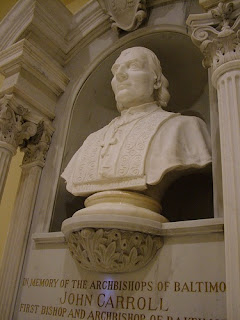
Sorry for the continued slow posting, folks. I'm still trying to process the events of last week... and in the feeble effort to do so, my brain remains a bit of a mess (...and the two-week e.mail backlog is growing even longer).
Some of you might be saying, "Well, what's new?" Of course, there's something to that... but this time, it's a bit more the case than usual.
Thing is, we're a bit luckier than the early church; they had ten days to prep for Pentecost... luckily, we've still got another two weeks. And something seems to say that, this year, the unleashing of the Holy Spirit -- the birthday of the church -- should be celebrated in an even more special way.
Why? Because we've been called to re-create it, on our own turf and in our own time. And if you missed any bit of our call to it, well, then thank God for massive bandwith.
Most of you probably aren't like me and, ergo, you caught every nuance and detail the first time around. But for the maybe-handful who could use a repeat showing of what went down over five magical days along the Eastern seaboard, on-demand video of every event is still up and streaming courtesy of the
USCCB, Boston's
Catholic TV and
EWTN.Even more important, however, there is the message of the so-called "Pope of Words"... who just so happened to pull out a stunning A-game of radiant energy on these shores, more than he's done over the rest of his three years on Peter's chair.
Lest anyone still be looking for a program, a roadmap for the future of the American Catholic project, it's in our midst. We've got it. And soon --
now -- the prayer and work begins to make it a reality.

Just like the best of everything in this church, it takes all comers and none among us is exempt from helping to bring it about. The twist, however, is that our old, defective ways won't suffice -- we can't just throw money at it, nor establish a diocesan office for it and say our work is done; if anything, the path ahead begins in the intimacy of every heart and mind, its fruits evident only in a renewed commitment on the part of us all, the standard by which we will be judged (...starting with the bishops at their
ad liminae next year).
It's a three-legged stool, church, and its pillars are succinct, but can often be difficult to put into practice: Unity. Renewal. Hope.

In order of reach, let's return to the texts together...
...and there you have it.
Everybody in? Hopefully so -- it's the only way we can make it happen.
Indeed, the visit was primarily a commemoration of history -- "the first great chapter" of the project's growth, as the Yankee homily put it.
They didn't have highways, nor cars, phones, e.mail, nor even steady clergy, parishes, any heat, electricity or running water in the beginning... but for everything they lacked, they were able to lay the foundations for the future we've inherited thanks to one simple quality:
they believed. And, really, who are we to do anything less?
I could go on and on... but even a week out, it'd still read like gibberish. Thankfully, the program given above is anything but -- it's serious stuff, and anyone who's serious about trudging forward and doing it effectively doesn't just owe this message a close, prayerful read, but to share it with those around us, those we serve, those we need to walk with us along the way.
In the meantime, though, one last quick word.
Almost unanimously, the PopeTrip's been deemed a success, the first glimmer of hope this national church has seen in quite some time.
But it didn't just happen out of thin air.

For the better part of a year, a phalanx of planners have spent every waking hour (or close to it) turning orders, plans and ideas into an event. Even before the
Volo Papale touched down, some had bloodshot eyes from long days in the office, and others, having done everything they could in the hope that it'd all just come together, even admitted to crying themselves to sleep some nights.
But in the end, it all did come together. Masterfully.
From communications and liturgies to security and logistics, folks civil and ecclesiastical -- many of 'em members of this little family of ours -- gave tens of thousands of hours to give the rest of us an experience we'll never forget.
Some won't see comp days or lost considerable time with their families, others are just relieved to still be vertical with the days of grace behind and glad to finally have a breather.
They are too many to name, but each and all deserve a ton of thanks. It never could've happened without 'em... and like those who came before us, we're all the better for the depth of their devotion.
PHOTOS: Reuters(1-4)
-30-
 The caption from Brazil:
The caption from Brazil:























